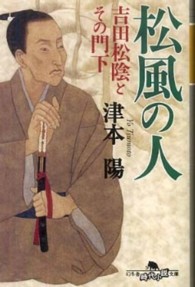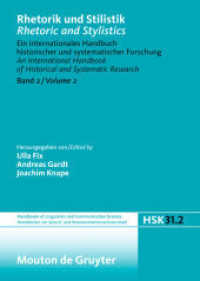Full Description
This unique volume focuses on the development of Chinese as a Second Language (CSL) teachers in the global context. It addresses the specific issues and challenges faced by CSL teachers and demonstrates international practices in the field. It also provides a comprehensive examination of their multifaceted professionalism from diverse perspectives.
With the rise of China as a political and economic power, learning CSL has increasingly gained its popularity in a global context. According to the Chinese International Education Foundation, by 2023, the number of registered Chinese language learners exceeded 12.5 million. Due to the shortage of teachers, the Ministry of Education in China launched the International Chinese Language Teachers Volunteer Program in 2004. By 2021, more than 61,000 volunteer Chinese language teachers had been dispatched to more than 151 regions and countries. Many more overseas universities, colleges, and higher institutes now have established CSL programmes at both undergraduate and postgraduate levels to cultivate local CSL teachers. However as the number of CSL learners continues to grow, the need for high-quality Chinese language teachers has become more urgent than ever. Responding to CSL teachers' challenges of delivering Chinese language and culture to learners from diverse language and cultural backgrounds, this book explores four interrelated themes: 1) CSL teachers' professional development in the global context, 2) CSL teachers' motivation, agency, and identity, 3) CSL teachers' knowledge and practice in multicultural and multilingual contexts, and 4) CSL teachers' technological literacy and agency in the digital era.
With its focus on both the internal and external complexities of CSL teacher development, the book offers timely insights and practical guidance for researchers, educators, policymakers, and frontline teachers working in this rapidly expanding field.
Contents
Table of Contents
Series Editors' Introduction
Acknowledgements
Preface
Foreword
List of Contributors
PART I: CSL TEACHERS' PROFESSIONAL DEVELOPMENT IN THE GLOBAL CONTEXT
1. RESEARCH ON CSL TEACHERS: A SYSTEMIC REVIEW OF STUDIES IN CHINESE AND ENGLISH ACADEMIC JOURNALS FROM 2014 TO 2023
Jing Yan and Hui Huang
2. THE DEVELOPMENT OF CSL TEACHERS IN THE GLOBAL CONTEXT
Xiliang Cui
3. CHALLENGING TEACHERS' PEDAGOGICAL APPROACHES: PROFESSIONAL LEARNING FOR MANDARIN TEACHERS IN ENGLAND AND SCOTLAND
Sin Manw Sophia Lam and Alan Huang
4. PROFESSIONAL DEVELOPMENT OF CHINESE LANGUAGE TEACHERS IN SINGAPORE: PATHWAYS AND TRANSFORMATIONS
Hock Huan Goh, Naoqi Sun, Chee Lay Tan and Dennis Kwek
PART II: CSL TEACHERS' MOTIVATION, AGENCY, AND IDENTITY
5. MOTIVATION OF CHINESE LANGUAGE IN-SERVICE TEACHERS IN A TARGET-LANGUAGE REMOVED AREA - INSIGHTS FROM AUSTRALIA
Hui Huang
6. EXAMINING CSL TRAINING THROUGH THE LENS OF TEACHER AGENCY IN CHINESE EDUCATION
Kaishan Kong
7. UNDERSTANDING THE PROFESSIONAL IDENTITY OF NON-NATIVE CHINESE-SPEAKING TEACHERS
Di Wang and Anqi Ding
PART III: CSL TEACHERS' KNOWLEDGE AND PRACTICE IN MULTICULTURAL AND MULTILINGUAL CONTEXTS
8. CHINESE HERITAGE LANGUAGE TEACHERS' INTRACULTURAL KNOWLEDGE AND PRACTICES: A MULTIPLE CASE STUDY IN CANADA
Guofang Li, Zhen Lin and Senyao Shen
9. CHINESE AS AN INTERNATIONAL LANGUAGE TEACHERS' UNDERSTANDING AND ACHIEVEMENT OF 'SIGNIFICANCE' UNDER THE QUALITY TEACHING FRAMEWORK
Scott Smith and Huiling Xu
10. MULTILINGUAL AWARENESS AND IDENTITY CONSTRUCTION IN MADARIN TEACHERS: A SOCIOCULTURAL PERSPECTIVE ON TEACHING PRACTICES
Chuyi Wang and Ying Zheng
PART IV: CSL TEACHERS' TECHNOLOGICAL LITERACY AND AGENCY IN THE DIGITAL ERA
11. EMPLOYING GAMIFICATION MECHANISMS IN PRIMARY SCHOOL CLASSROOMS: A CASE STUDY OF A CHINESE LANGUAGE TEACHER
Sinyee Lau, Sujin He and Yun Wen
12. THE PROFESSIONAL DEVELOPMENT OF PRE-SERVICE TEACHERS OF CHINESE AS A SECOND LANGUAGE TO APPLY INNOVATIVE TECHNOLOGY TO CHINESE EDUCATION
Hsiujen Cheng
13. CHINESE LANGUAGE TEACHER AGENCY IN ONLINE TEACHING: A MULTIPLE CASE STUDY
Juan Yang
14. THE FUTURE OF CSL TEACHER DEVELOPMENT: GLOBAL PERSPECTIVES AND DIRECTIONS
Hui Huang and Jing Yan
Index








